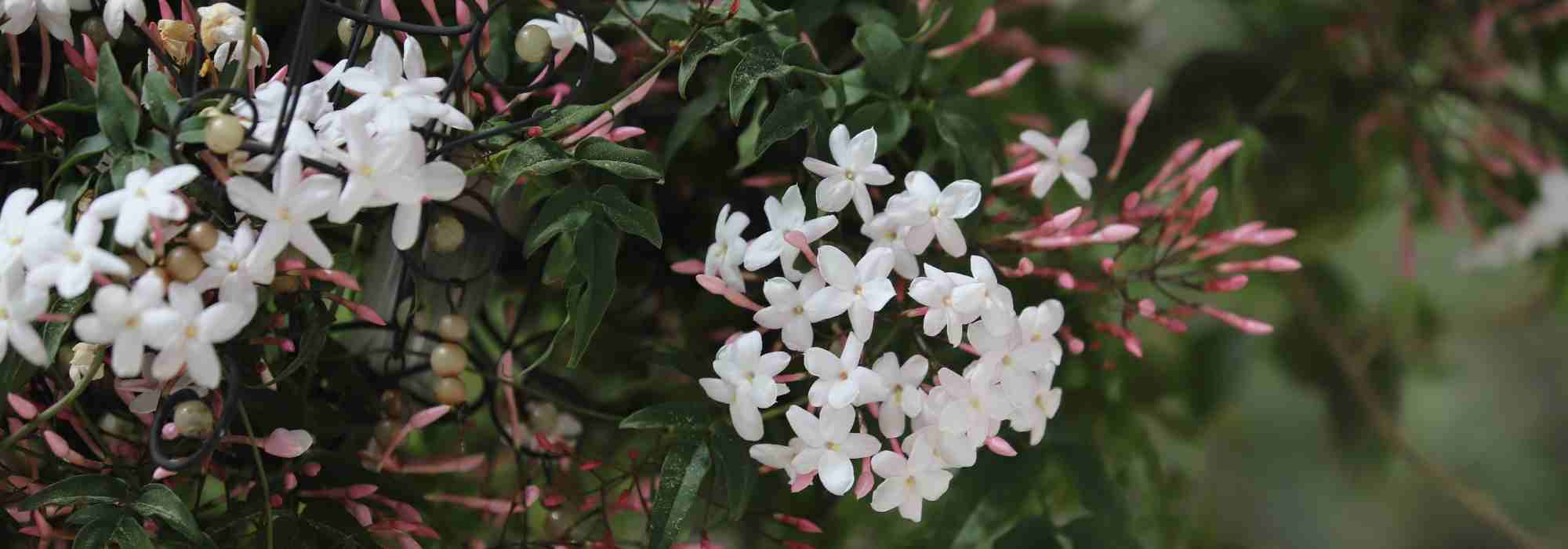
Which jasmine to plant according to your region?
Varieties suitable for planting in pots or in the ground
Contents
Originating from various countries across the Asian continent and thriving in its natural medium in tropical zones, jasmine enchants with its elegance, whiteness, divine fragrances, and the touch of exoticism it imparts. While the star jasmine is quite distinct from common jasmine, many varieties remain less utilised and known in our regions, as there is not just one… but many jasmines! Some are actually non-fragrant, some are deciduous, others are evergreen or semi-evergreen, with most being climbing plants, though some take on a shrubby form…
It is primarily its hardiness that will guide your choice between different jasmines for your garden or terrace, as it is often a rather tender plant. Will you be able to grow jasmine in the ground or only in pots? In this advice sheet, we offer a brief overview of the different varieties of jasmines that can be successfully installed depending on the region where you live.
→ Learn all about jasmine in our comprehensive guide. Also, check out our article How to choose a jasmine?
You live in the Mediterranean region
You are among the lucky ones who will have a wide choice, as the Mediterranean fringe and the Corsican coast enjoy an exceptionally mild climate in winter, warmth in summer, and nighttime temperatures rarely dipping near freezing: ideal growing conditions for all jasmines! (N.B. We are referring to USDA hardiness zone 10 here).
This region alone allows you the luxury of planting non-hardy jasmines directly in the ground without fear, so indulge yourself with the stunning and highly fragrant Arabian jasmine (Jasminum sambac), Jasminum polyanthum (white jasmine) with its porcelain pink flowers, as well as the Spanish jasmine or Jasmin grandiflorum.
You can, of course, also plant the hardier jasmines that we will discuss for other regions below, from Stephan’s jasmine to common jasmine, including the famous star jasmine (Trachelospermum jasminoides), whether in pots or in the ground, depending on your available space and your preferences for colour, foliage height, and fragrances…
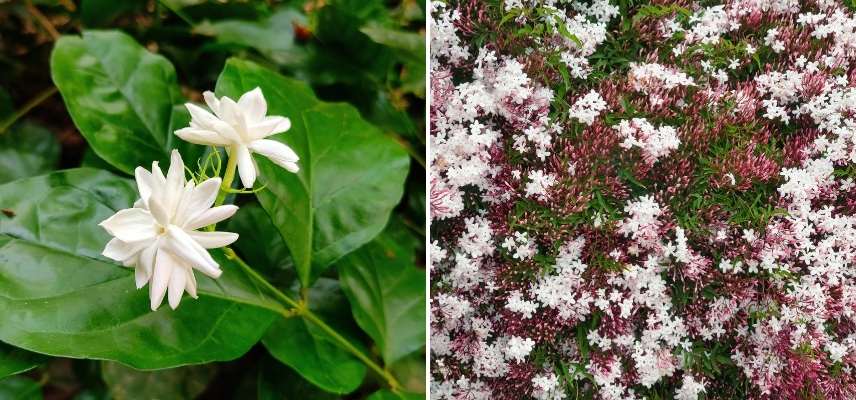
In a very mild climate, don’t miss out on the fragrances of Jasminum sambac (on the left) and Jasminum polyanthum, beautifully planted in the ground, where it covers a large area with its 3 m height, perfuming the garden!
Read also
Jasmin : planting, pruning and careYou live on the Atlantic fringe
This coastal fringe running along the entire French coast from Cotentin to Hendaye is another extremely privileged geographical area as it benefits from a microclimate due to the maritime influences of the ocean and the Gulf Stream towards Brittany. (This is USDA hardiness zone 9).
With cooler summer temperatures, but consistently mild conditions and very few significant frosts, gardens in the Atlantic fringe allow for the growing of certain evergreen jasmines or those that will remain so in this climate, such as the spring-flowering Jasminum mesneyi, with its beautiful yellow hue, the magnificent Jasminum azoricum (or Azorean jasmine), which is summer-flowering with star-shaped white flowers, or the Jasminum multipartitum, also white, with stunning pink buds and large starry flowers.
You can also grow in the ground, and even more so in pots, Jasminum humile (also yellow), false jasmines (Trachelospermum jasminoides), Asian jasmines (Jasminum asiaticum) which are similar to false jasmines, and all the less hardy jasmines mentioned later in this article, giving you a wide range ultimately, both in flower colours and in deciduous, semi-evergreen, or evergreen jasmines.
Only the perfumer’s jasmines mentioned around the Mediterranean could suffer during harsh winters (which will happen, surprisingly, it must be understood, with climate change).
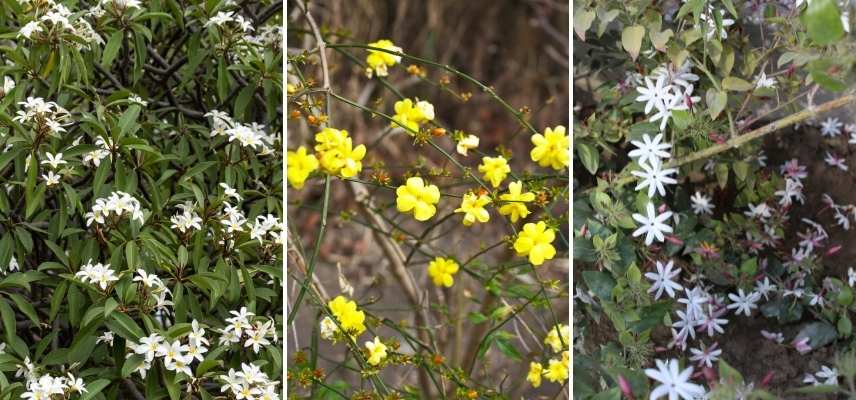
From left to right: Jasminum azoricum, Jasminum mesneyi and Jasminum multipartitum
Discover other Jasmine
View all →Available in 0 sizes
Available in 0 sizes
Available in 0 sizes
Available in 1 sizes
Available in 3 sizes
Available in 3 sizes
Available in 1 sizes
Available in 1 sizes
Available in 1 sizes
Available in 0 sizes
You live in an oceanic region
These are the regions experiencing an oceanic influence, across a broad western band of France, extending to the centre, excluding the reliefs (we are here in USDA zones 8). In this climatic zone (which includes the altered oceanic climate in Angers, for example, and the degraded oceanic climate in Paris), frosts of -5 to -10°C can occur, depending on how far one is from the ocean, which will necessitate a somewhat more limited choice, and most often a pot culture.
For cultivation in open ground, it will be the deciduous jasmines that will withstand significant temperature fluctuations, but they will always require a carefully chosen location (against a wall, in a sunny but not scorching exposure, sheltered from winds). You could, for example, plant a common jasmine (also known as jasmine officinal), blooming in summer with a myriad of fragrant white flowers. It grows tall up to 10m and remains semi-evergreen in the mildest regions, being hardy down to -10°C. The Stéphanois jasmine (Jasminum x stephanense) is also a very beautiful jasmine, pink in colour, capable of withstanding frosts down to -10°C. Care should be taken for these two varieties, which are sensitive to prolonged frosts, to mulch the base well before winter to protect them as much as possible. For a change of colour, a jasminum humile, yellow, with a more bushy form, will suit the western regions of this zone as it requires plenty of sun and warmth to flower well.
Finally, star jasmines and Jasminum asiaticum, which are also resistant down to -10°C, can be planted both in the garden and on the terrace, in pots where they will develop less. Opt for pot planting for all these cultivars as soon as you live east of the Lille-Clermont-Ferrand axis, except in city gardens where they benefit from a small microclimate. The Jasminum nudiflorum or winter jasmine is perfectly at home in these regions, bringing its cascade of yellow colour for long weeks during the coldest part of the year!
From these regions, however, be cautious with pot planting, remembering that the hardiness of a plant is reduced by 1 to 4 degrees in this type of culture, providing less protection than in open ground…

From left to right: Jasminum x stephanense (© L Enking), Jasminum officinale, Trachelospermum asiaticum
Read also
Choosing a JasmineYou live in a semi-continental climate region
If you live in the east of France and in the plains around the other mountain ranges of the Hexagon, you are already experiencing a semi-continental climate, as the ocean’s inertia is no longer sufficient to bring enough warmth at night.
In these regions where the thermometer drops lower in winter, the varieties of jasmines will be limited to winter jasmine for open ground and star jasmines for pot planting. However, this still allows for the use of the superb and numerous varieties of Trachelospermums, such as Trachelospermum asiaticum ‘Pink Showers’, whose pink flowering is truly astonishing, or the variegated foliage of ‘Sun Lover’. If you have a conservatory or a cold greenhouse, you can even grow a low-growing jasmine in a pot, such as Jasminum officinale ‘Clotted Cream’ with its lovely cream-yellow flowers.
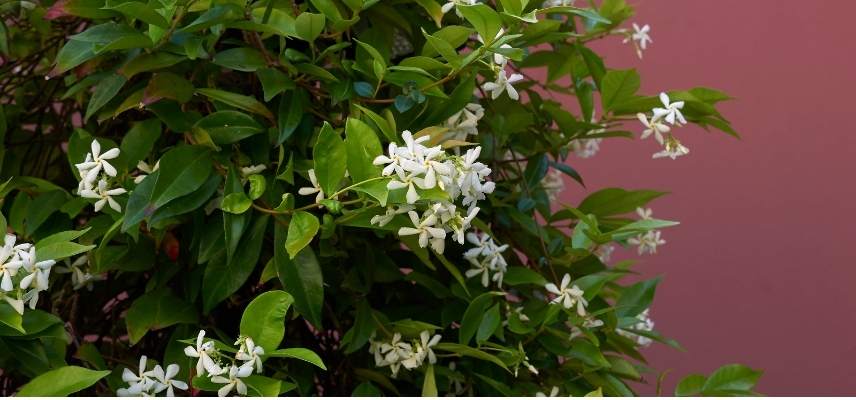
A star jasmine is well-suited for regions with cold winters, provided it is planted in a pot and wintered in a bright location.
You live in a mountainous region with a continental climate
In a continental climate and at altitude (USDA zone 6), you cannot rely on fragrant jasmines or the more tender jasmines mentioned above, unless you grow them in pots, wintering them and placing them on a sunny terrace not before early June, and bringing them indoors as soon as temperatures approach zero, sometimes as early as October in mountainous regions… not exactly ideal. There are other hardy climbing plants better suited to your climate.
The winter jasmine is an interesting option to bring a beautiful green cascade to your garden or terrace, with spectacular yellow flowering in winter as it is the hardiest jasmine, resistant to temperatures down to -15°C, thus cultivable in certain low mountain areas. You can pair your winter jasmine with other plants to enhance its appearance once it has finished flowering.
Star jasmines (Trachelospermum jasminoides), evergreen, will also be useful for enjoying a long flowering period in late spring: they are hardy, but only down to -10°C. These are the ones you can grow in large pots. To give them the best chance, place them sheltered from prevailing winds, in a well-sunny spot, against a wall for good protection, or on the terrace. You must winter them in winter in a cold greenhouse or conservatory.
→ Also read our Top 5 hardiest jasmines.

The winter jasmine is quite resilient, and properly sheltered, will offer you its stunning winter flowering
To learn more about the hardiness of plants
Consult our articles dedicated to hardiness conditions and climate zones:
- Subscribe!
- Contents
































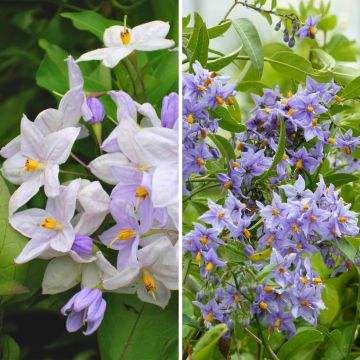




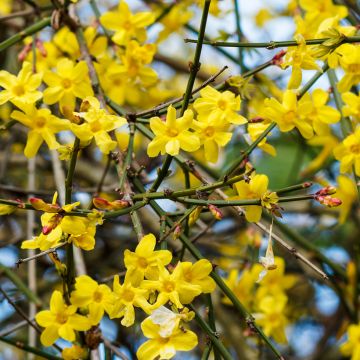



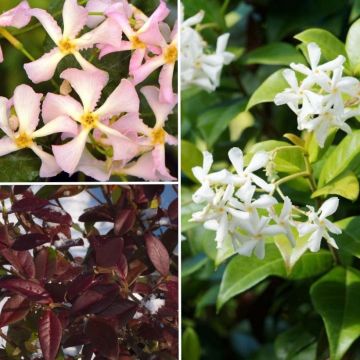
Comments